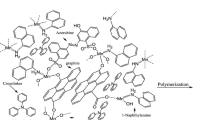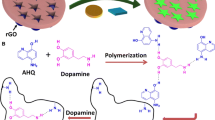Abstract
The molecularly imprinted electrochemical aptasensor was constructed based on co-deposition of zinc oxide and gold nanoparticles/reduced graphene oxide composite. Aptamer was used as a new kind of functional monomer and the aptamer-amoxicillin complex was formed by hydrogen bond. Then, the complex was fixed on the surface of the modified electrode by Au–S bond. Three-dimensional imprinted polymeric membrane was formed by electropolymerization of dopamine, and the imprinted sites with good specificity and affinity were formed after elution. Combined with the specificity of molecularly imprinted technology and the affinity of aptamer, the selective recognition of amoxicillin can be realized. Under the optimal experimental conditions, the linear range was from 10−14 to 10−8 M, and the detection limit was 3.3 × 10−15 M. The sensor exhibited satisfactory selectivity, repeatability, and stability and was successfully used for 10−9 M amoxicillin determination in real water and food samples.
Graphical abstract









Similar content being viewed by others
References
Rojanarata T, Opanasopit P, Ngawhirunpat T, Saehuan C, Wiyakrutta S, Meevootisom V (2010) A simple, sensitive and green bienzymatic UV-spectrophotometric assay of amoxicillin formulations. Enzyme Microb Technol 46:292–296. https://doi.org/10.1016/j.enzmictec.2009.11.011
Sun L, Jia L, Xie X, Xie K, Wang J, Liu J, Cui L, Zhang G, Dai G, Wang J (2016) Quantitative analysis of amoxicillin, its major metabolites and ampicillin in eggs by liquid chromatography combined with electrospray ionization tandem mass spectrometry. Food Chem 192:313–318. https://doi.org/10.1016/j.foodchem.2015.07.028
Manzo V, Honda L, Navarro O, Ascar L, Richter P (2014) Microextraction of non-steroidal anti-inflammatory drugs from waste water samples by rotating-disk sorptive extraction. Talanta 128:486–492. https://doi.org/10.1016/j.talanta.2014.06.003
Zhang Y, Lai K, Zhou J, Wang X, Rasco BA, Huang Y (2012) A novel approach to determine leucomalachite green and malachite green in fish fillets with surface-enhanced Raman spectroscopy (SERS) and multivariate analyses. J Raman Spectrosc 43:1208–1213. https://doi.org/10.1002/jrs.4050
Saini A, Singh J, Kaur R, Singh N, Kaur N (2015) Fluoremetric determination of amoxicillin drug in aqueous medium using hybrid framework of organic-inorganic nanoparticles. Sens Actuators B Chem 209:524–529. https://doi.org/10.1016/j.snb.2014.12.018
Hasanpour F, Ensafi AA, Khayamian T (2010) Simultaneous chemiluminescence determination of amoxicillin and clavulanic acid using least squares support vector regression. Anal Chim Acta 670:44–50. https://doi.org/10.1016/j.aca.2010.05.001
Yola ML, Eren T, Atar N (2014) Molecular imprinted nanosensor based on surface plasmon resonance: application to the sensitive determination of amoxicillin. Sens Actuators B Chem 195:28–35. https://doi.org/10.1016/j.snb.2014.01.011
Huang Y, Ye D, Yang J, Lu H, Li L, Ding Y (2022) A novel dual-signal molecularly imprinted electrochemical sensor based on NiFe prussian blue analogue and SnS2 for detection of p-Hydroxyacetophenone. Chem Eng J 435:134981. https://doi.org/10.1016/j.cej.2022.134981
Alizadeh T, Amjadi S (2017) A tryptophan assay based on the glassy carbon electrode modified with a nano-sized tryptophan-imprinted polymer and multi-walled carbon nanotubes. New J Chem 41:4493–4502. https://doi.org/10.1039/c6nj04108f
Tuerk C, Gold L (1990) Systematic evolution of ligands by exponential enrichment: RNA ligands to bacteriophage T4 DNA polymerase. Science (New York, N.Y.) 249:505–510. https://doi.org/10.1126/science.2200121
Eissa S, Zourob M (2017) Selection and characterization of DNA aptamers for electrochemical biosensing of carbendazim. Anal Chem 89:3138–3145. https://doi.org/10.1021/acs.analchem.6b04914
Rad AO, Azadbakht A (2019) An aptamer embedded in a molecularly imprinted polymer for impedimetric determination of tetracycline. Microchim Acta 186:56. https://doi.org/10.1007/s00604-018-3123-9
Roushani M, Ghanbarzadeh M, Shahdost-Fard F (2021) Fabrication of an electrochemical biodevice for ractopamine detection under a strategy of a double recognition of the aptamer/molecular imprinting polymer. Bioelectrochemistry 138:107722. https://doi.org/10.1016/j.bioelechem.2020.107722
Shen M, Kan X (2021) Aptamer and molecularly imprinted polymer: synergistic recognition and sensing of dopamine. Electrochim Acta 367:137433. https://doi.org/10.1016/j.electacta.2020.137433
Ensafi AA, Amini M, Rezaei B (2018) Molecularly imprinted electrochemical aptasensor for the attomolar detection of bisphenol A. Microchim Acta 185:265. https://doi.org/10.1007/s00604-018-2810-x
Yu C, Li L, Ding Y, Liu H, Cui H, Zhang F, Lin J, Duan Y (2021) A sensitive molecularly imprinted electrochemical aptasensor for highly specific determination of melamine. Food Chem 363:130202. https://doi.org/10.1016/j.foodchem.2021.130202
Zan G, Wu T, Zhang Z, Li J, Zhou J, Zhu F, Chen H, Wen M, Yang X, Peng X, Chen J, Wu Q (2022) Bioinspired nanocomposites with self-adaptive stress dispersion for super-foldable electrodes. Adv Sci 9:2103714. https://doi.org/10.1002/advs.202103714
Zan G, Wu T, Dong W, Zhou J, Tu T, Xu R, Chen Y, Wang Y, Wu Q (2022) Two-level biomimetic designs enable intelligent stress dispersion for super-foldable C/NiS nanofiber free-standing electrode. Adv Fiber Mater 4:1177–1190. https://doi.org/10.1007/s42765-022-00162-7
Sui R, Zan G, Wen M, Li W, Liu Z, Wu Q, Fu Y (2022) Dual carbon design strategy for anodes of sodium-ion battery: mesoporous CoS2/CoO on open framework carbon-spheres with rGO encapsulating. ACS Appl Mater Interfaces 14:28004–28013. https://doi.org/10.1021/acsami.2c06551
Huang Y, Lin J, Duan Y, Yu C, Li L, Ding Y (2022) Preparation of carbon fiber composite modified by cobalt lanthanum oxides and its electrochemical simultaneous determination of amlodipine and acetaminophen. Adv Fiber Mater 4:1153–1163 https://doi.org/10.1007/s42765-022-00159-2
Zan G, Wu T, Zhu F, He P, Cheng Y, Chai S, Wang Y, Huang X, Zhang W, Wan Y, Peng X, Wu Q (2021) A biomimetic conductive super-foldable material. Matter 4:3232–3247. https://doi.org/10.1016/j.matt.2021.07.021
Shen L, Ye D, Zhao H, Zhang J (2021) Perspectives for single-atom nanozymes: advanced synthesis, functional mechanisms, and biomedical applications. Anal Chem 93:1221–1231. https://doi.org/10.1021/acs.analchem.0c04084
Chai S, Zan G, Dong K, Wu T, Wu Q (2021) Approaching superfoldable thickness-limit carbon nanofiber membranes transformed from water-soluble PVA. Nano Lett 21:8831–8838. https://doi.org/10.1021/acs.nanolett.1c03241
Jain R, Thakur A, Kumar P, Pooja D (2018) Au/ZnO nanocomposites decorated ITO electrodes for voltammetric sensing of selenium in water. Electrochim Acta 290:291–302. https://doi.org/10.1016/j.electacta.2018.09.061
Afzali P, Abdi Y, Arzi E (2014) Directional reduction of graphene oxide sheets using photocatalytic activity of ZnO nanowires for the fabrication of a high sensitive oxygen sensor. Sens Actuators B Chem 195:92–97. https://doi.org/10.1016/j.snb.2013.12.105
Wang Y-H, Huang K-J, Wu X (2017) Recent advances in transition-metal dichalcogenides based electrochemical biosensors: a review. Biosens Bioelectron 97:305–316. https://doi.org/10.1016/j.bios.2017.06.011
Zhang X, Wang Y, Hou F, Li H, Yang Y, Zhang X, Yang Y, Wang Y (2017) Effects of Ag loading on structural and photocatalytic properties of flower-like ZnO microspheres. Appl Surf Sci 391:476–483. https://doi.org/10.1016/j.apsusc.2016.06.109
Yadav AK, Verma D, Lakshmi G, Eremin S, Solanki PR (2021) Fabrication of label-free and ultrasensitive electrochemical immunosensor based on molybdenum disulfide nanoparticles modified disposable ITO: an analytical platform for antibiotic detection in food samples. Food Chem 363:130245. https://doi.org/10.1016/j.foodchem.2021.130245
Yu J, Yu X (2008) Hydrothermal synthesis and photocatalytic activity of zinc oxide hollow spheres. Environ Sci Technol 42:4902–4907. https://doi.org/10.1021/es800036n
Lu W, Gao S, Wang J (2008) One-pot synthesis of Ag/ZnO self-assembled 3D hollow microspheres with enhanced photocatalytic performance. J Phys Chem C 112:16792–16800. https://doi.org/10.1021/jp803654k
Zhu L, Li Y, Zeng W (2018) Hydrothermal synthesis of hierarchical flower-like ZnO nanostructure and its enhanced ethanol gas-sensing properties. Appl Surf Sci 427:281–287. https://doi.org/10.1016/j.apsusc.2017.08.229
Ojani R, Raoof J-B, Zamani S (2012) A novel voltammetric sensor for amoxicillin based on nickel-curcumin complex modified carbon paste electrode. Bioelectrochemistry 85:44–49. https://doi.org/10.1016/j.bioelechem.2011.11.010
Chowdhury TR, Shaikh AA, Akter H, Neaz MM, Bakshi PK, Ahammad AJS (2014) Highly sensitive detection of amoxicillin based on gold nanoparticle-modified ITO electrode. ECS Solid State Lett 3:P14–P16. https://doi.org/10.1149/2.003402ssl
Fouladgar M, Hadjmohammadi MR, Khalilzadeh MA, Biparva P, Teymoori N, Beitollah H (2011) Voltammetric determination of amoxicillin at the electrochemical sensor ferrocenedicarboxylic acid multi wall carbon nanotubes paste electrode. Int J Electrochem Sci 6:1355–1366
Chullasat K, Nurerk P, Kanatharana P, Davis F, Bunkoed O (2018) A facile optosensing protocol based on molecularly imprinted polymer coated on CdTe quantum dots for highly sensitive and selective amoxicillin detection. Sens Actuators B Chem 254:255–263. https://doi.org/10.1016/j.snb.2017.07.062
Ji W, Wang L, Qian H, Yao W (2014) Quantitative analysis of amoxicillin residues in foods by surface-enhanced Raman spectroscopy. Spectrosc Lett 47:451–457. https://doi.org/10.1080/00387010.2013.807843
Funding
The National Natural Science Foundation of China provided funding (No. 22274096).
Author information
Authors and Affiliations
Corresponding authors
Ethics declarations
Conflict of interest
The authors declare no competing interests.
Additional information
Publisher's note
Springer Nature remains neutral with regard to jurisdictional claims in published maps and institutional affiliations.
Supplementary information
Below is the link to the electronic supplementary material.
Rights and permissions
Springer Nature or its licensor holds exclusive rights to this article under a publishing agreement with the author(s) or other rightsholder(s); author self-archiving of the accepted manuscript version of this article is solely governed by the terms of such publishing agreement and applicable law.
About this article
Cite this article
Lu, H., Huang, Y., Cui, H. et al. A molecularly imprinted electrochemical aptasensor based on zinc oxide and co-deposited gold nanoparticles/reduced graphene oxide composite for detection of amoxicillin. Microchim Acta 189, 421 (2022). https://doi.org/10.1007/s00604-022-05497-x
Received:
Accepted:
Published:
DOI: https://doi.org/10.1007/s00604-022-05497-x




